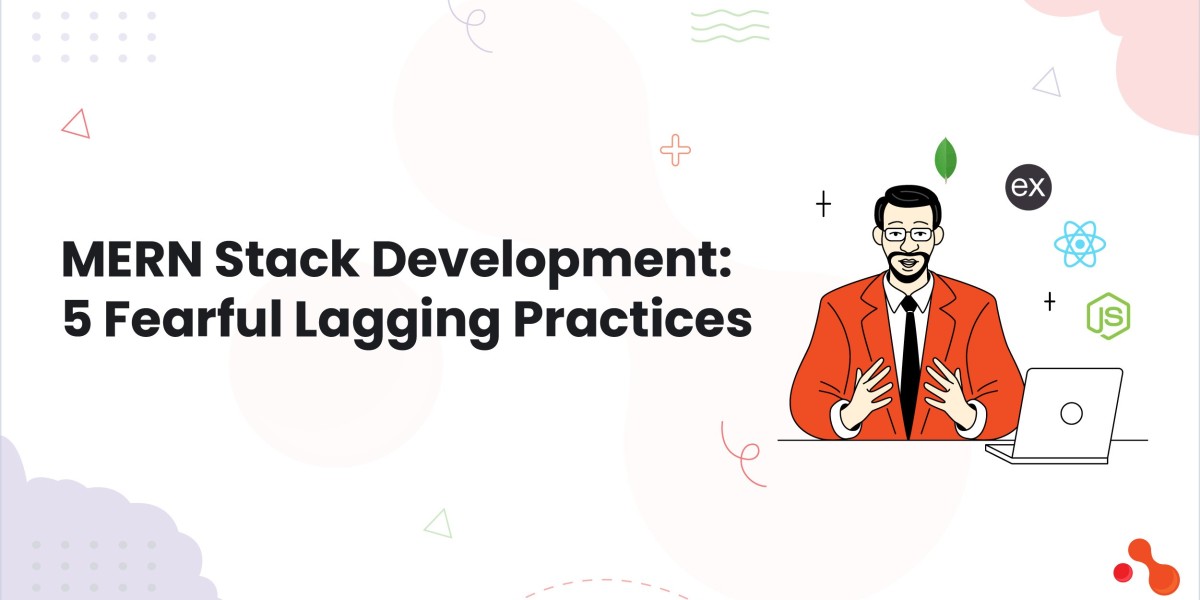Introduction
The MERN stack, with its integration of MongoDB, Express.js, React, and Node.js, has become very popular for building dynamic, scalable web apps. However, with such powerful technologies at their command, development teams still encounter significant problems if they stick to practices that are trailing.
These outdated or inefficient methodologies decrease productivity, increase costs, and lower the quality of the end product. In this in-depth review, we shall look at some of the lagging practices that may affect MERN stack development and consider strategies to help us overcome these challenges.
Understanding MERN Stack Development
Before considering lagging practices, it's pertinent to understand what makes the MERN stack different from other frameworks and why developers prefer it over others.
MongoDB
MongoDB is a NoSQL database that stores data in flexible, JSON-like documents, making it very effective at scaling and performing for applications consuming large amounts of unstructured data.
Express.js
Express.js is a Node.js web application framework that is minimal and flexible, offering a robust set of functionality for developing web and mobile applications. This makes development easier by providing a thin layer of the core functionalities of the web application.
React.js
It's a JavaScript library with the purpose of building user interfaces, mostly single-page applications that need display of dynamically changing data. React will help developers in the creation of large web apps that change data without refreshing the page.
Node.js
Node.js is a runtime environment for JavaScript that is built on top of Chrome's V8 JavaScript. This makes it possible to use JavaScript for server-side code due to the facilities provided by the JavaScript developers, thus enabling the building of an entire application with just one language.
Now, further let us a few common lagging practices in MERN Stack Development
5 Lagging Practices of MERN Stack Development
Despite the benefits of working with the MERN stack, developers fall into the trap of using poorly updated or inefficiently practiced processes that may become a bottleneck in their work. Here are some typical lagging practices that apply to MERN stack development:
Poor Code Quality
Thus, writing good, clean, maintainable code is the prime factor that determines long-term success in any software project. However, many a time, since it's usual to ignore coding standards, this leads to poor code quality and might turn your code into something incomprehensible, hard to maintain, and debug.
Consequence
- More Time Spent Debugging: Badly written code will result in more bugs and errors, which take more time to debug and correct.
- Reduced Maintainability: When code is not well-structured or well-documented, then maintaining or updating it becomes tough.
- Decreased Team Morale: Working through bad code can be highly frustrating; it lowers the morale of developers and reduces their productivity.
Solutions
- Code Reviews: Put regular code reviews into practice to make sure coding is being done according to set standards and any type of issue can be tackled quickly.
- Linting Tools: Use some linting tools like ESLint that can easily detect and fix coding issues on the go and provide a consistent codebase.
- Documentation: Good documentation and the use of sensible variable and function names can help to make code more understandable and maintainable.
Poor Automation of Testing
In software development, automated testing tools is a critical process involved in ensuring the reliability and stability of an application. However, many development teams either omit testing completely or rely solely on manual testing, which is time-consuming and often affected by human error.
Impact
- Increased Risk of Bugs: Without automation tests, bugs and errors lie unidentified, surfacing only when they reach the production environment.
- Slower Development Cycle: Manual testing slows the development process, mostly when it has to be repeated frequently.
- Reduced Confidence: If there is not a strong test framework in place, a developer can end up lacking confidence in the stability of his code, hence being afraid to make any change or update.
Solutions
- TDD (Test-Driven Development): With TDD, it is clear that the tests will surely be written before the code, leading to more reliable and less buggy code.
- Automated Testing Tools: These include Jest, Mocha, and Cypress, among others, which automate the testing process.
- Continuous Integration: With the implementation of Continuous Integration practices, all the tests will run every time a code commit is made, thereby ensuring that all issues are identified at the very outset of the development cycle.
Poor Version Control
Software development depends heavily on version control to trace changes, back proper collaboration, and fall back on revisions where necessary. But still, some teams over-rely on outdated version control practices, or just do not use version control effectively.
Impact
- Difficult in Collaboration - If version control is not proper, then at the least, it would cause several developers operating on the same codebase to cause conflicts and overwrites.
- Code Loss: Lack of decent version control means at any point a loss of code or updates if something goes wrong and cannot get back to a specific previous state.
- Inconsistent Codebase: It would now be cumbersome to work on keeping your codebase consistent. This discrepancy will then lead to integration problems eventually.
Solutions
- Git: Next-Gen version control tools like Git help teams track changes, handle branches, and ultimately work together seamlessly.
- Adopting branching strategies like Git Flow will ensure that the development and merging of different features and bug fixes are done in a methodical manner.
- Pull Requests: Applied, pull requests can make sure that code is peer-reviewed and tested before it reaches the main codebase.
Inefficient Deployment Processes
Deployment is the most crucial stage of a software development life cycle. In fact, most development teams still practice manual deployment processes. These are time-consuming and, even worse, more error-prone.
Impact
- Higher Risk of Errors: Due to the use of manual processes in deployment, there is a superior amount of human error. This leads to possible issues in the production environment.
- Slower Time-to-Market: Ineffective deployment will slow down the release of new features and updates to users.
- Inconsistent Environments: Without automated deployment, achieving consistency across development, staging, and production becomes a tough task.
Solutions
- Continuous Deployment (CD): It is a software release practice, where every code change goes through the entire pipeline before being released to the end users.
- Infrastructure as Code (IaC): Tools like Terraform and AWS CloudFormation help in managing infra in a consistent and repeatable way.
- Containerization: Adopting containerization technologies like Docker ensures that applications run consistently in different environments.
Performance Gets Overlooked
Performance in any web application is key to success, but more often, development teams overlook it leading to sluggish and unresponsive apps.
Impact
- Poor User Experience: Slowly loading pages and non-responsive applications will only offer a poor user experience, and hence user satisfaction and engagement decrease.
- Resource Consumption: In this case, inefficient code in the product increases the server resource consumption, and eventually, operational cost increases.
- Slow websites lower their search engine rankings, reducing visibility and traffic since performance is a key factor.
Solutions
- One can identify bottlenecks and points for improvement by conducting performance testing.
- Optimizing Code: Optimizing the code will make it more efficient and less complex, therefore enhancing performance.
- Caching: This includes Redis, which lightens the server load and quickens response.
- CDNs: Content delivery networks can place content closer to the user to have as little latency as possible and increase load times.
Now, moving ahead let us learn about the Best Practices for MERN Stack Development
Best Practices for MERN Stack Development
Avoid pitfalls of trailing practices and ensure the success of MERN stack development projects through best practices. This would include initiatives against better efficiency, quality, and collaboration. Use efficient MERN Stack development tools to minimize development delays.
Embrace Agile Methodologies
Agile methodologies like Scrum and Kanban support iterative development on the basis of constant feedback and collaboration. With Agile practices, the Development Team can quickly react to change, deliver incremental value, and manage projects more effectively.
Prioritize Documentation
A good code base should have extensive documentation for the code base, requirements, and processes at one's fingertips. Therefore, prioritizing documentation will allow proper sharing of knowledge, easy onboarding of new developers, and more manageable ways of maintaining the codebase.
Implement Efficient Security Measures
Security is the paramount concern in a web development project. Strong security measures in a development cycle can safeguard an application from probable threats and vulnerabilities. These security measures must cover input validation, authentication, authorization, and encryption.
Culture of Continuous Learning
The tech industry is fast-changing, and keeping up to date with trends, tools, and best practices is relevant within this context. With a culture of continuous learning, development teams will stand at a vantage position to move at the forefront, improve their skills, and deliver quality solutions.
Apply DevOps Practices
Most DevOps practices encourage collaboration among development and operation teams, which can help smoothen the development process, increase deployment efficiency, and boost overall application performance. By adopting DevOps practices, teams can achieve faster time-to-market, quality releases, and better scaling.
Now, further let us discuss about a few Statistics on Lagging Practices
Few Statistics on Lagging Practices
Let us learn a few statistics about impact of lagging practices in MERN Stack Development
Code Quality: According to one study by Stripe and Harris Poll, developers spend 17.3 hours on an average per week to deal with bad code, costing companies an estimated $85 billion annually in lost productivity.
Automated Testing: A study by the World Quality Report 2020-2021 exposes that solely 15% of organizations have reached full test automation, hence pointing at a vast gap in the automated testing practice.
Version control: A survey by GitLab disclosed that 92% of developers use Git. However, only 37% use the advanced features to help with CI/CD, which shows that there is room for improvement in the practice of version control.
Deployment Processes: According to Puppet's research, good DevOps teams deploy 208 times more often and recover from incidents 106 times faster compared to bad DevOps teams.
Performance Optimization: Google states that 53% of mobile site visitors leave a webpage if it takes more than three seconds to load.
Now, before ending the discussion let us understand the difference between Lagging Practice and Best Practices
Difference between Lagging Practices with Best Practices
| Aspect | Lagging Practice | Best Practice | Impact |
|---|---|---|---|
| Code Quality | Writing poorly structured and undocumented code | Implementing code reviews, using linting tools, and thorough documentation | Reduced debugging time, improved maintainability, higher team morale |
| Automated Testing | Relying solely on manual testing | Adopting TDD, utilizing automated testing tools, implementing CI | Increased bug detection, faster development cycle, higher confidence |
| Version Control | Using outdated or inadequate version control practices | Utilizing Git, adopting branching strategies, using pull requests | Enhanced collaboration, better code tracking, reduced code loss |
| Deployment Processes | Relying on manual deployment | Implementing CD, using IaC, adopting containerization | Reduced risk of errors, faster time-to-market, consistent environments |
| Performance Optimization | Overlooking performance optimization techniques | Conducting performance tests, optimizing code, implementing caching, using CDNs | Improved user experience, lower resource consumption, higher search engine ranking |
Now, moving further let us discuss how Acquaint Softtech can help in building a Best MERN Stack development Practice.
How can Acquaint Softtech help in building Best Practices for MERN Stack Development
We are an IT outsourcing company called Acquaint Softtech which provides two services: IT staff augmentation and software development outsourcing. As an official Laravel partner, we enjoy building new applications using the Laravel framework.
Acquaint Softtech is the best choice if your business is looking to hire remote developers. With our accelerated onboarding process, developers can join your in-house team in as little as 48 hours.
Because of our $15 hourly rate, we are also the best choice for any type of outsourced software development task. We can assist you with hiring remote developers. Moreover you can also hire MEAN stack developers, hire MERN stack developers, and outsourced development services to meet your need for specialized development. Let's work together to take your business to new heights.
Closing Notes!
In conclusion, when lagging practices are not followed, the MERN stack enables productive implementation of today's web applications with its powerful and flexible base.
Only by spotting and handling those outdated methodologies and practices, and including some of the best practices like Agile methodologies, comprehensive documentation, robust security measures, continuous learning, and DevOps practices can development teams enhance their efficiency, improve code quality, and deliver a better user experience.
Acquaint Softtech can enable businesses to implement such best practices, ensuring that the development projects with MERN Stack drive innovation and growth in the competitive tech landscape.










